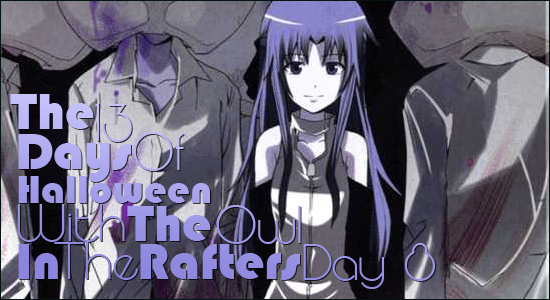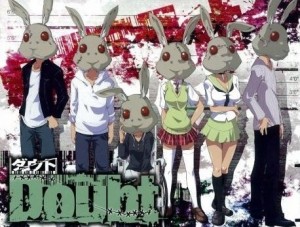13 Days of Halloween with The Owl in the Rafters: Day 8

 Halloween countdown, Day 8: Today I’d like to step away from the monsters and the sci-fi and touch on a more modern take on horror. In the wake of the massively successful SAW film franchise the trend toward psychological thrillers, gruesome ultimatums, ultra-gore, and mind games became a major focus in some rings of the horror fan community. The problem I have with this is that it relies a lot on the same old tricks and really sticks to just one basic formula. That formula does do a fair job of doing what it is supposed to, so it isn’t as if it’s a flawed one, but there’s something less than satisfying about seeing the same old tricks time and time again, even if they never really fail. Specifically, setting up an entire cast of characters all with perfectly feasible motives to being a murderer and then leaving you to guess at which as they get picked off one by one. It’s always fairly unpredictable but it’s always the same cast of character archetypes and who the murderer is always the least obvious, which in turn makes them the most obvious.
Halloween countdown, Day 8: Today I’d like to step away from the monsters and the sci-fi and touch on a more modern take on horror. In the wake of the massively successful SAW film franchise the trend toward psychological thrillers, gruesome ultimatums, ultra-gore, and mind games became a major focus in some rings of the horror fan community. The problem I have with this is that it relies a lot on the same old tricks and really sticks to just one basic formula. That formula does do a fair job of doing what it is supposed to, so it isn’t as if it’s a flawed one, but there’s something less than satisfying about seeing the same old tricks time and time again, even if they never really fail. Specifically, setting up an entire cast of characters all with perfectly feasible motives to being a murderer and then leaving you to guess at which as they get picked off one by one. It’s always fairly unpredictable but it’s always the same cast of character archetypes and who the murderer is always the least obvious, which in turn makes them the most obvious.
 Anyhow… the title we’re going over today is ‘s Doubt. (Sometimes mistakenly referred to as “Rabbit Doubt”.) Aptly titled for the psychological games it tries to play with the cast. The premise is that a cellphone based game called Rabbit Doubt is played with random people from around the Tokyo area. The game is essentially a less dynamic version of the party game Mafia/Assassin/Werewolf/Witch Hunt: there is one wolf and five rabbits making up six players. The players must find out which of them is the wolf and stop him/her before they are all eliminated from the game. In the voting phase all players agree upon a player to eliminate, and in the following phase, the wolf eliminates a player if he/she hasn’t already been eliminated. The game cycles through the two phases until the wolf is found and eliminated or the rabbits are all eliminated.
Anyhow… the title we’re going over today is ‘s Doubt. (Sometimes mistakenly referred to as “Rabbit Doubt”.) Aptly titled for the psychological games it tries to play with the cast. The premise is that a cellphone based game called Rabbit Doubt is played with random people from around the Tokyo area. The game is essentially a less dynamic version of the party game Mafia/Assassin/Werewolf/Witch Hunt: there is one wolf and five rabbits making up six players. The players must find out which of them is the wolf and stop him/her before they are all eliminated from the game. In the voting phase all players agree upon a player to eliminate, and in the following phase, the wolf eliminates a player if he/she hasn’t already been eliminated. The game cycles through the two phases until the wolf is found and eliminated or the rabbits are all eliminated.
Not mentioned but inferred is that a single rabbit cannot “vote” to eliminate the wolf by him/her self once the other rabbits are all gone, so technically the wolf wins by being one of two last standing players, not simply the very last. There is of course an issue in that with such a small group this is inherently flawed in that the game would end in just two rounds.
In any case, the six players in one particular group get together for an offline meeting just for fun, along with them is the main character’s childhood friend. After a little bit of partying one member goes missing, the hero goes to find him, and then gets knocked unconscious by a person wearing a rabbit mask. All seven characters wind up in a strange locked down facility with no memory of how they got there. The first discovery is that one of the original six is dead, bringing the total player count to a neat and tidy six again. Additionally the locked doors all around the facility are openable only by scanning one of six barcodes, printed on the skin of six of the seven captives. You’ll notice there’s one less barcode than there are players, and of course the one character missing his is the hero.
Speaking of which I’ll go over the actual characters just briefly. First is of course the hero, Yuu. He is one of the original six players meeting each other on the day of the event and the token hero of the bunch: ignorant, honest, hopelessly confused, and determined to trust and save everyone involved… at least at first. His childhood friend, Mitsuki, happens to meet him on the way to the offline meeting and tags along as the group goes to a karaoke bar and wakes up along with the others after they’re all abducted by “The Wolf”. She fulfills the role of the damsel in distress and spends the better half of the story hiding behind Yuu and occasionally freaking out. The first of the other players start with Eiji, your typical temperamental highschool punk with a crude mouth, a bad attitude, and violent tendencies, and Haruka, a curvaceous high school girl who doesn’t really have any major defining characteristics outside of being the girl that isn’t totally helpless. Last to the party is Rei, a sweet and innocent looking young girl in a wheelchair and former child celebrity now without a career. The final addition to the cast is Hajime, the oldest of the group who doesn’t actually appear until after the abduction where Yuu wakes up in the same room with him. Hajime is the level headed and outwardly cold member of the team, sporting generic smart-guy glasses and pokerface.
The story pans out as you might expect, with each character having their own dirty little secrets, each with their own idea of who the killer is and how to escape, and as the tension builds between captives, the murder continues to take every opportunity to kill off the others one by one. The theme present in all of this is of course doubt-vs-trust, but also lies. Each character isn’t simply suspected of being the killer, their alibis and their own ethical accountabilities are scrutinized for the lies they tell. Everyone has something to hide, and everyone has a motive. The team starts off fairly well united but naturally break down into a paranoia, backstabbing mess in good time. The paranoia is a strong factor and as the group desperately tries to keep on track with some kind of logical approach to their escape, the emotional and fear based reactions tear the team apart one member at a time.
Quite the opposite of the last two titles I’ve gone over, due to the initially mentioned issues with the modern horror/thriller formula, as well as a few other reasons I’ll go over, I would normally have placed Doubt earlier on the list had I been judging on quality alone, but admittedly this kind of simplistic, spelling-everything-out-for-you kind of horror/thriller tends to much more accessible to a modern audience, regardless of age, and technically does a better job of soliciting the same general fear and anxiety response out of an audience, even if I have gripes with the artistic and literary quality of it. The characters aren’t really given enough time to develop too far, but certainly they show some small amount of depth, enough for a single layer of deception in most cases. The tension and drama plays out one string at a time, usually with the person most suspect being the next victim, and of course ending with the least suspicious being the killer. Hope that wasn’t too big a spoiler, but honestly if you’ve ever seen any kind of murder mystery before you should be able to see that much coming from about a mile away. In other words, it is kind of bland and generic, but as far as I’ve seen it’s this kind of straight forward plot that proves more consistently scary to a broader audience.
 One of the other reasons I would normally not have ranked this as high would be the art. It’s not “bad” by any right, but it’s so eye-rollingly generic that if people weren’t dying and stabbing each other in the back left and right I’d have dropped it after the color pages ended. The artist and author is Yoshiki Tonogai, artist of the Higurashi no Naku Koro Ni: Himatsubushi Arc manga. He may easily be the only remotely decent artist to have worked on any of the Higurashi no Naku Koro Ni franchise but that really isn’t saying much. (Seriously, you would think that with ten different manga drawn by 8 different artists you’d have at least ONE who can actually draw a hand, wrist, ankle, and/or hip that don’t look hideously malformed even BEFORE torture scenes.) Other than that however Tonogai’s only works have been the four volume long Doubt and its still ongoing sequel, Judge.
One of the other reasons I would normally not have ranked this as high would be the art. It’s not “bad” by any right, but it’s so eye-rollingly generic that if people weren’t dying and stabbing each other in the back left and right I’d have dropped it after the color pages ended. The artist and author is Yoshiki Tonogai, artist of the Higurashi no Naku Koro Ni: Himatsubushi Arc manga. He may easily be the only remotely decent artist to have worked on any of the Higurashi no Naku Koro Ni franchise but that really isn’t saying much. (Seriously, you would think that with ten different manga drawn by 8 different artists you’d have at least ONE who can actually draw a hand, wrist, ankle, and/or hip that don’t look hideously malformed even BEFORE torture scenes.) Other than that however Tonogai’s only works have been the four volume long Doubt and its still ongoing sequel, Judge.
 Judge is visually almost identical to Doubt, right down to the dopey looking “creepy” animal masks, and like Doubt it plays entirely upon the group distrust plot device. This time around there are nine abductees, no apparent relations between any of them (yet), and the claim that they have each committed a sin which they will be judged for. Once again one of the players is found DOA by the time the hero wakes up, and leaves the party with just eight people. After a short bit of searching the central room of the confinement chamber, they find a video cassette with a very Jigsaw-styled fox doll with voice-over giving orders and instructions on how the game is played. The rules of the game are simple: within a designated time limit all prisoners must enter into their own assigned voting station their vote for who to kill off. That is all. There is room to negotiate, to threaten, to trick, to betray, and of course to lie.
Judge is visually almost identical to Doubt, right down to the dopey looking “creepy” animal masks, and like Doubt it plays entirely upon the group distrust plot device. This time around there are nine abductees, no apparent relations between any of them (yet), and the claim that they have each committed a sin which they will be judged for. Once again one of the players is found DOA by the time the hero wakes up, and leaves the party with just eight people. After a short bit of searching the central room of the confinement chamber, they find a video cassette with a very Jigsaw-styled fox doll with voice-over giving orders and instructions on how the game is played. The rules of the game are simple: within a designated time limit all prisoners must enter into their own assigned voting station their vote for who to kill off. That is all. There is room to negotiate, to threaten, to trick, to betray, and of course to lie.
So, if mindgames, murderer mysteries, drama, and logical deduction are your cup of tea then I’d highly recommend both Doubt and Judge as a well rounded exercise in all of the above.

















I’m not a thriller type guy, but I can see how this can catch some people’s fancy.